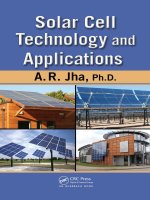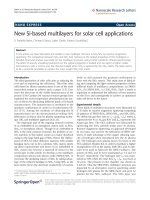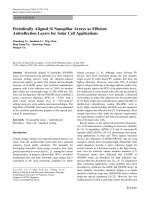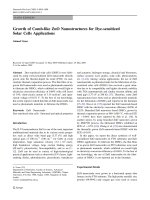GRAPHENE ZINC OXIDE NANOCOMPOSITE FOR SOLAR CELL APPLICATIONS
Bạn đang xem bản rút gọn của tài liệu. Xem và tải ngay bản đầy đủ của tài liệu tại đây (26.89 MB, 98 trang )
GRAPHENE-ZINC OXIDE NANOCOMPOSITE FOR SOLAR CELL
APPLICATIONS
LEE GAH HUNG
B. ENG. (HONS.) NUS
A THESIS SUBMITTED
FOR THE DEGREE OF MASTER OF SCIENCE
DEPARTMENT OF PHYSICS
NATIONAL UNIVERSITY OF SINGAPORE
2015
DECLARATION
I hereby declare that this thesis is my original work and it has been written by me in its
entirety. I have duly acknowledged all the sources of information which have been used in
the thesis.
This thesis has also not been submitted for any degree in any university previously.
_________________
LEE GAH HUNG
11 June 2015
i
Acknowledgement
Firstly, I would like to give thanks to the Lord for giving me a chance to pursue
graduate studies and doing a research project in National University of Singapore (NUS). The
journey has been filled with highs and lows, but it is definitely a fruitful soul searching
experience.
Next, I would like to express my gratitude to my supervisors, Prof Wee Thye Shen,
Andrew and Associate Prof Ho Ghim Wei for giving me much needed guidance, assistance
and support throughout the entire course of the project.
Finally, I would like to express my appreciation to Mr. Thomas Ang Tong Chuan from
ESP Multidisciplinary Lab; Dr. Kevin Moe and Mr Lim Fang Jeng for guiding me and
assisting me throughout this project; and lastly Ms Gao Minmin and Ms Wang Ying Chieh
for being such wonderful student in the lab and the assistance given throughout.
ii
Table of Contents
DECLARATION ................................................................................................................... i
Acknowledgement ................................................................................................................ ii
Table of Contents ................................................................................................................. iii
Abstract ............................................................................................................................... vi
List of Tables ...................................................................................................................... vii
List of Figures ..................................................................................................................... vii
Chapter 1
1.1
Introduction ...................................................................................................... 1
Background on Zinc Oxide ............................................................................... 1
1.1.1
Properties of Zinc Oxide ................................................................................... 1
1.1.2
Applications of Zinc Oxide ............................................................................... 5
1.1.3
Synthesis methods of Zinc Oxide materials ....................................................... 6
1.1.3.1
Chemical Vapour Deposition (CVD)......................................................... 6
1.1.3.2
Physical Vapour Deposition (PVD)........................................................... 7
1.1.3.3
Solution based synthesis ........................................................................... 8
1.2
Background on Graphene .................................................................................. 8
1.2.1
Structures of Graphene...................................................................................... 8
1.2.2
Properties of Graphene.................................................................................... 10
1.2.2.1
Surface properties ................................................................................... 10
1.2.2.2
Electrical properties ................................................................................ 11
1.2.2.3
Optical properties.................................................................................... 12
1.2.2.4
Mechanical properties ............................................................................. 13
1.2.2.5
Thermal properties .................................................................................. 14
1.2.3
Synthesis of Graphene Materials ..................................................................... 14
1.2.3.1
Direct Exfoliation ................................................................................... 14
1.2.3.2
Epitaxial Growth..................................................................................... 15
1.2.3.3
Chemically Derived Graphene ................................................................ 16
1.3
Chapter 2
Organization of Thesis .................................................................................... 18
Synthesis and patterning of ZnO nanowires .................................................... 22
2.1
Background .................................................................................................... 22
2.2
Synthesis of ZnO nanomaterials ...................................................................... 25
2.2.1
Synthesis of ZnO nanoparticles ....................................................................... 25
2.2.2
Synthesis of ZnO nanowires (Hydrothermal method) .................................... 266
iii
2.2.2.1
Formation of seed layer ........................................................................... 26
2.2.2.2
Hydrothermal method I (M1) .................................................................. 26
2.2.2.3
Hydrothermal method II (M2) ............................................................... 277
2.3
Patterning of ZnO nanomaterial ...................................................................... 27
2.3.1
2.4
Substrate Cleaning .......................................................................................... 27
Photolithography Process .............................................................................. 288
2.4.1
2.5
UV Lithography .............................................................................................. 28
Results and Discussion.................................................................................... 29
2.5.1
Synthesis of ZnO nanowires............................................................................ 29
2.5.1.1
Seed layer formation ............................................................................... 29
2.5.1.2
Synthesis of ZnO nanowires.................................................................... 30
2.5.1.3
Effects of pH on morphology .................................................................. 32
2.5.1.4
Role of Polyethylenimine (PEI) .............................................................. 34
2.5.1.5
ZnO nanowire with multiple growth ....................................................... 35
2.5.2
Photolithography............................................................................................. 37
2.5.2.1
Varying Exposure Time .......................................................................... 37
2.5.2.2
Varying the growth methods on the pattern. ............................................ 38
2.5.3
Growth of ZnO nanowires on patterned substrates .......................................... 39
2.5.3.1
Growth of ZnO nanowires on FTO substrate ........................................... 39
2.5.3.2
Growth of ZnO nanowires on GZO substrate .......................................... 40
2.6
Summary ........................................................................................................ 42
Chapter 3
3.1
Graphene Oxide and Graphene Composites: Synthesis and Characterization ... 45
Synthesis of Graphene Oxide .......................................................................... 45
3.1.1
Introduction .................................................................................................... 45
3.1.2
Oxidation of Graphite ..................................................................................... 47
3.1.3
Washing and exfoliation of Graphite Oxide .................................................... 48
Vacuum filtration method ........................................................................................ 48
3.1.3.1
3.2
Centrifugation ......................................................................................... 49
Characterization of Graphene Oxide ............................................................... 50
3.2.1
Morphological characterization ....................................................................... 51
3.2.2
Structural Characterization .............................................................................. 53
3.2.3
Optical Characterization.................................................................................. 57
iv
3.3
Synthesis of Graphene-ZnO Composites ......................................................... 57
3.3.1
Introduction .................................................................................................... 57
3.3.2
One-pot synthesis of composites ..................................................................... 58
3.4
Characterization of Graphene-ZnO composites ............................................... 59
3.4.1
Morphological Characterization ...................................................................... 59
3.4.2
Structural Characterization .............................................................................. 60
3.4.3
Optical Characterization.................................................................................. 62
3.5
Chapter 4
4.1
Conclusion ...................................................................................................... 63
Graphene-ZnO composite Dye Sensitised Solar Cell ....................................... 66
Introduction .................................................................................................... 66
4.1.1
Zinc Oxide Dye Sensitized Solar Cell ............................................................. 66
4.1.2
Photoreduction of Graphene Oxide ................................................................. 68
4.1.3
Graphene-ZnO Dye Sensitized Solar Cell ....................................................... 71
4.2
Synthesis and Fabrication of Devices .............................................................. 72
4.2.1
Synthesis of ZnO aggregates ........................................................................... 72
4.2.2
Photoreduction of Graphene Oxide with ZnO ................................................. 72
4.2.3
Fabrication and Characterization of Dye Sensitized Solar Cell ........................ 72
4.3
Results and Discussions .................................................................................. 74
4.3.1
ZnO aggregates ............................................................................................... 74
4.3.2
Photoreduced GO-ZnO nanocomposites.......................................................... 77
4.3.3
rGO-ZnO nanostructures DSSC ...................................................................... 78
4.4
Chapter 5
Conclusion ...................................................................................................... 84
Conclusion ...................................................................................................... 86
v
Abstract
ZnO nanowires was grown using two different solution based method. It was found that
by using different pH in the growth solution, ZnO nanowire with different morphology was
produced. The patterning of ZnO nanowires was successfully done on different substrates
using photolithography technique. Variation in the pitch of the patterns and also the use of
different growth solution are shown to control the desired nanostructures. Meanwhile,
graphene oxide sheet as large as 60μm was produced based on modified Hummer’s method.
A one-pot synthesis of rGO-ZnO composite has also been developed which reduces the GO
and at the same time forms the rGO-ZnO nanoparticle composite, using mild and scalable
conditions. ZnO aggregates and rGO-ZnO nanocomposites have also been successfully
synthesised using photoreduction method. Lastly, the ZnO nanostructures and rGO-ZnO
nanocomposites synthesised was incorporated into the design of photoanode of dye sensitized
solar cell to boost the efficiency. An improved efficiency of 4.92% was achieved for
patterned ZnO nanowire dye sensitized solar cell through enhanced light scattering and
charge collection. However, the increase in efficiency of dye sensitized solar cell when
graphene is incorporated has not been achieved. Further investigations need to be done to
elucidate the ineffectiveness of as-synthesized graphene-ZnO nanocomposite for solar cell
application.
vi
List of Tables
Table 1.1 – List of important properties of pristine graphene. .............................................. 10
Table 1.2 – Mechanical properties of single, bi-layer and multiples layer of graphene [12]. . 13
Table 4.1 – Amount of GO and ZnO aggregates added to form nanocomposites.................. 77
Table 4.2 – Summary of results of photoreduced GO-ZnO aggregate nanocomposites DSSC
with different wt.% of graphene .......................................................................... 84
List of Figures
Figure 1.1 – Ball and stick model of the wurtzite crystal structure, with grey balls
representing zinc atoms and yellow balls representing oxygen atoms [1]. .............. 2
Figure 1.2 – SEM image of epitaxially grown ZnO crystals with clear hexagonal symmetry. 2
Figure 1.3 – Common planes of the Wurtzite crystal structure [2]. ........................................ 3
Figure 1.4 – A comparison of the bandgaps and electron affinities of various semiconducting
compounds in relation to the redox potentials required for water splitting [8]. ....... 5
Figure 1.5 – Various applications of zinc oxide materials. ..................................................... 6
Figure 1.6 – (a) Honeycomb structure of graphene. (b) Graphene as the basic building block
of other graphitic materials. [15] ........................................................................... 9
Figure 1.7 – Structure of reduced graphene oxide, showing structural imperfections. [12] ... 10
Figure 1.8 – Ambipolar electric field effect in monolayer graphene [15]. ............................ 12
Figure 1.9 – Graphene layer is built up on copper foil and then used rollers to transfer the
graphene to a polymer support and then onto a final substrate. [17] ..................... 15
Figure 1.10 – Schematic diagram of chemical synthesis of graphene. .................................. 16
Figure 1.11 – Structure of highly hydrophilic graphite oxide. [12] ....................................... 17
Figure 2.1 – Solubility of ZnO in aqueous solution versus pH and ammonia concentration at
(a) 25ºC (b) 90ºC and versus pH and temperature at (c) 0 mol L-1 and (d) 1 mol L-1
ammonia concentration [1]. ................................................................................. 24
Figure 2.2 –Speciation in an aqueous solution of dissolved Zn(II) versus pH at (a) 25°C and
(b) 90°C and of dissolved ammonia at (c) 25°C and (d) 90°C, with 0.5 mol L-1
ammonia [1]........................................................................................................ 25
Figure 2.3 – A flow chart illustrates the details on preparation of substrates. ....................... 27
Figure 2.4 – (a) Contact printing system (b) The pattern of the mask under light microscope.
........................................................................................................................... 29
Figure 2.5 – Atomic Force Microscope image of ZnO seed layer on a silicon substrate. ...... 29
vii
Figure 2.6 – SEM image of the top view of ZnO nanowires grown using hydrothermal method
I. ......................................................................................................................... 31
Figure 2.7 – SEM image of side view of ZnO nanowires grown using hydrothermal method I.
........................................................................................................................... 31
Figure 2.8 – SEM image of the top view of ZnO nanowires grown using hydrothermal method
II ......................................................................................................................... 32
Figure 2.9 – SEM image of side view of ZnO nanowires grown using hydrothermal method II.
........................................................................................................................... 32
Figure 2.10 – Crystal planes of a ZnO nanowire [4]. ............................................................ 33
Figure 2.11 – SEM image of side view of ZnO nanowires grown using hydrothermal method
II for two times. .................................................................................................. 36
Figure 2.12 – SEM image of side view of ZnO nanowires grown using hydrothermal method
II for three times. ................................................................................................ 36
Figure 2.13 – SEM image of the top view of ZnO nanowires grown using M1 with exposure
time of (a) 5s (b) 7s (c) 10s (d) 15s...................................................................... 38
Figure 2.14 – SEM image of the ZnO nanowires grown using M1 with exposure time (a) 7s (b)
10s (c) 15s........................................................................................................... 38
Figure 2.15 – SEM images of the top view of ZnO nanowires grown using M2 at different
magnifications. ................................................................................................... 39
Figure 2.16 – SEM images of the side view of ZnO nanowires grown using (a) M1 (b) M2
method. ............................................................................................................... 39
Figure 2.17 – SEM images of ZnO nanowires on patterned FTO substrate. .......................... 40
Figure 2.18 – SEM images of ZnO nanowires obtained through M2 method on patterned
GZO substrate. .................................................................................................... 41
Figure 2.19 – SEM images of ZnO nanowires obtained through M1 method on patterned GZO
substrate. ............................................................................................................. 41
Figure 2.20 – SEM images of ZnO nanowires obtained through M1 with measurement on
patterned GZO substrate...................................................................................... 42
Figure 3.1 – Illustration of oxidation of graphite to graphene oxide and reduction to reducedgraphene oxide [2]. ............................................................................................. 46
Figure 3.2 – Experimental setup for oxidation of graphite. .................................................. 48
Figure 3.3 – Schematic diagram of experimental setup for oxidation of graphite. ................ 48
Figure 3.4 – Schematic diagram showing the setup for vacuum filtration............................. 49
Figure 3.5 - (a) Optical microscope image of a few-layer GO sheet; (b) the GO sheet in (a)
under higher magnification ................................................................................. 52
viii
Figure 3.6 – SEM image of graphene oxide with measurements shown. .............................. 53
Figure 3.7 – XRD pattern of graphene oxide. ...................................................................... 54
Figure 3.8 – Low resolution TEM image of a few-layer GO sheet. ...................................... 55
Figure 3.9 – High resolution TEM image of a few-layer GO sheet ...................................... 55
Figure 3.10 – High resolution TEM image of a few-layer GO sheet showing sheet edge. .... 56
Figure 3.11 – Electron diffraction pattern of a GO sheet ...................................................... 56
Figure 3.12 – UV-Vis absorption spectrum of GO sheets. ................................................... 57
Figure 3.13 – (a) GO dispersed in methanol (b) rGO-ZnO composites in water ................... 59
Figure 3.14 – SEM images of rGO-ZnO composite ............................................................. 60
Figure 3.15 – XRD pattern of rGO-ZnO composite, rGO and GO. ...................................... 61
Figure 3.16 – TEM image of rGO-ZnO composite: (a) and (b) low resolution image, (c) high
resolution image.................................................................................................. 62
Figure 3.17 – UV-Vis absorption spectrum for rGO-ZnO composite, ZnO nanoparticle, GO
and rGO. ............................................................................................................. 63
Figure 4.1 – Schematic diagram of the working principle of a DSSC in general [1]. ............ 66
Figure 4.2 – Color intensity variation of graphene oxide solution during photoreduction
process: a) before irradiation; b) start of irradiation; c) after 30 minutes of
irradiation; d) after 2 hours of irradiation [3]. ...................................................... 69
Figure 4.3 – Excited state interaction between ZnO nanoparticles and Graphene Oxide [4]. 70
Figure 4.4 – Schematic diagram of photoreduction of GO by ZnO nanorods [5]. ................. 71
Figure 4.5 – Schematic diagram of an assembled dye sensitized solar cell ........................... 73
Figure 4.6 – Diagram of an actual dye sensitized solar cell fabricated.................................. 73
Figure 4.7 – SEM image of ZnO aggregates at different magnifications. ............................. 75
Figure 4.8 – TEM image of individual ZnO nanoparticles in the ZnO aggregates ................ 76
Figure 4.9 – rGO-ZnO nanocomposites with different wet% of graphene oxide................... 77
Figure 4.10 – SEM images of photoreduced GO-ZnO nanocomposites with (a) 0.1 wt.% (b)
0.5 wt.% (c) 1.0 wt.% (d) 3.0 wt.% of GO incorporated. ..................................... 78
Figure 4.11 - Efficiency of the DSSC fabricated using different designs of photoanode....... 80
Figure 4.12 – Photocurrent density versus voltage curves for DSSCs with their photoanode
design shown in Figure 4.11. ............................................................................... 81
Figure 4.13 – Diagram showing the effects of patterning on light scattering. The arrow shows
the direction of light shone onto the photoanode.................................................. 82
ix
Figure 4.14 – SEM image of the side view of a representative sample of DSSC using
photoreduced GO-ZnO aggregates composites as photoanode. ............................ 83
x
Chapter 1 Introduction
1.1 Background on Zinc Oxide
ZnO is an inorganic compound commonly found in everyday
applications and products. These include pigments in paints, cigarette filters
and even food additives. It also serves as an additive to improve the structural
durability and inherent stability of rubber and concrete. Thus, while the
presence of ZnO might at times be subtle, its usefulness in the modern life
cannot be disputed.
However, in more recent times, there has been a heightened interest in
ZnO as an optoelectronic material. Endeavors to exploit the properties of ZnO
in light emitting diodes, solar cells and energy harvesting devices require a far
higher level of understanding of the material’s properties. This level of
sophistication had to be matched with advancements in characterization
techniques and crystal growth methods in order for useful devices to be
fabricated.
1.1.1 Properties of Zinc Oxide
ZnO is commonly found in the hexagonal wurtzite form under standard
conditions. The lattice comprises two hexagonal close packed (HCP)
arrangements of Zn and O ions that are translated along the c-axis relative to
one another, as shown in Figure 1.1.
1
Figure 1.1 – Ball and stick model of the wurtzite crystal structure, with grey balls representing
zinc atoms and yellow balls representing oxygen atoms [1].
The inherent hexagonal symmetry of the ZnO lattice can be clearly
seen in crystal growth when performed near equilibrium as shown in Figure
1.2. The low index planes of ZnO that can be commonly observed include the
polar (0001) and (000-1) planes, and the non-polar (11-20) and (1-100) side
plane as shown in Figure 1.3.
Figure 1.2 – SEM image of epitaxially grown ZnO crystals with clear hexagonal symmetry.
2
Figure 1.3 – Common planes of the Wurtzite crystal structure [2].
Incidentally, the Wurtzite structure lacks inversion symmetry, and is
responsible for ZnO’s piezoelectric properties. Its remarkable piezoelectric
behavior has been intensely investigated in the hope of producing energy
harvesting devices that can extract energy from mechanical vibrations and
subsequently convert them into electrical energy [3].
The structural configuration of Zn and O ions in 3-dimensional space
also gives ZnO its optical and electrical properties. The resulting electronic
band structure gives it a wide, direct bandgap of about 3.3eV [4]. This,
coupled with its high exciton binding of 60meV, has made it an attractive
material for near-UV light emitting diodes. Its wide bandgap also allows it to
be transparent across the visible spectrum of light, making it useful as
transparent conductors when ZnO is degenerately doped.
Electrically, ZnO is intrinsically n-type material due to unintentional
introduction of hydrogen atoms into the lattice during crystal growth.
Furthermore, the formation of intrinsic defects such as oxygen vacancies and
Zn interstitials act as donors, thus contributing to the n-type behavior.
3
However, existing DFT studies have suggested that intrinsic defects might not
play a significant role due to a combination of high formation energies of the
defects and the high activation energies needed for electrons to be excited to
the conduction band (deep donors). As such, the general consensus is that H
remains chiefly responsible for the observed n-type conductivity. Such
behavior of H is peculiar to ZnO since in most other semiconductors studied,
H always opposes the prevailing conductivity. However, in ZnO, H always
functions as a donor [5]. The introduction of H into the lattice can occur via
the presence of hydroxides or water molecules in hydrothermally grown
crystals, or through the decomposition of metal-organic compounds
commonly used in CVD.
Efforts to deliberately dope ZnO n-type include the introduction of
group 3 elements to substitute Zn ions, or group 7 elements to substitute O
ions. Such approaches have been used to fabricate transparent conducting
oxides mainly for photovoltaic applications to give carrier concentrations of
the order of 1020 [6].
Depending on the crystal plane in question, ZnO generally has an
electron affinity in the range of 3.7-4.6 eV [7]. This allows the conduction
band and valence band energies of ZnO to straddle many important redox
reactions, thus allowing it to participate in important photocatalytic reactions.
Figure 1.4 shows the positions of conduction and valence bands of various
semiconductors in relation to the redox potentials necessary for the
decomposition of water to H2 and O2 gas. The fact that the conduction and
valence bands of ZnO straddle the redox potential of water (marked in pink)
4
means that photogenerated electron-hole pairs have sufficient energy to
generate both O2 and H2, making ZnO a possible candidate for photocatalytic
water splitting. This usefulness is a direct consequence of the position of the
valence and conduction bands, which in turn are dependent on the electron
affinity and bandgap of ZnO.
Perhaps more relevant to this work, the placements of the conduction
band of ZnO allows it to receive electrons from light-absorbing dyes in DSSCs.
This requires the conduction band of ZnO to be slightly lower than the LUMO
of the respective dyes. If this condition is not met, photogenerated electrons
cannot be separated, and no photovoltaic effect will be realized in the solar
cell.
Figure 1.4 – A comparison of the bandgaps and electron affinities of various semiconducting
compounds in relation to the redox potentials required for water splitting [8].
1.1.2 Applications of Zinc Oxide
The areas in which ZnO can be applied in modern technologies are
dependent on its properties, many of which have already been mentioned
5
above. In particular, one finds that ZnO can be used in technologies that are
related to environmental sustainability, be it in clean energy generation,
energy efficient devices or hazardous gas sensors [9, 10] (as summarized in
Figure 1.5).
Energy generation
Energy efficiency
•Solar cell TCO layers
•Dye-sensitized solar cell
photoanodes
•Piezoelectric generators
•Light emitting diodes
•Lasers
ZnO
Photocatalysis
Others
•Water splitting for H2 generation
•Photodegradation of organic
materials
•Gas & volatile organic molecule
sensors
•Photodetector
•Thinfilm transistors
Figure 1.5 – Various applications of zinc oxide materials.
1.1.3 Synthesis methods of Zinc Oxide materials
Another versatile aspect of ZnO as a material is that it lends itself to a
large variety of methods by which it can be synthesized. It is important to give
a brief overview of the common ways ZnO has been synthesized because
many of its physical and chemical properties are dependent on the method of
preparation.
1.1.3.1 Chemical Vapour Deposition (CVD)
Many variants of chemical vapour deposition (CVD) processes have
been employed to deposit ZnO. CVD is actively used to deposit many other
materials at an industrial scale, making it important to understand the
underlying chemistry and growth habits of CVD grown films. The precursors
of ZnO are introduced to the reaction chamber in vapour phase, followed by
subsequent transport of the precursors to the reaction surface. CVD deposition
6
allows for the deposition on large substrates, high throughput and film
uniformity.
Metal organic CVD (MOCVD). This technique forms the basis of most
ZnO CVD growth. It involves the use of diethylzinc as a source of Zn,
together with an oxidizing agent for the formation of ZnO. Diethylzinc reacts
violently with air, thus requiring the process to be carried out in an inert
environment. Doping can be achieved by the addition of the dopant in the
vapour phase.
Atomic layer deposition (ALD). ALD is conceptually similar to
MOCVD, but the oxidizer and Diethylzinc are added sequentially, allowing
highly conformal coverage of ZnO films with monolayer accuracy. In addition
to this, it has been demonstrated that ALD can achieve high optical quality
ZnO films at relatively low deposition temperatures (~200ºC) (Extremely low
temperature growth of ZnO by atomic layer deposition)
1.1.3.2 Physical Vapour Deposition (PVD)
Common PVD methods include sputtering and pulsed laser deposition
(PLD). Sputtering is a vacuum based technique commonly used to produce
multilayer films of different compositions. Despite its industrial prevalence, it
remains that sputtering only produces ZnO of film morphology. PLD on the
other hand, has been known to be able to produce nanowire morphologies
under suitable deposition conditions. This can be achieved by restricting the
flux of the ablated material to the substrate, allowing vapour-liquid-solid
growth of ZnO to occur. Control over the nanowire densities have also been
demonstrated [11]. To accomplish this, masks have been put in between the
7
target and the substrate (ZnO nanowire morphology control in pulsed laser
deposition), or by adjusting the target-substrate distance.
1.1.3.3 Solution based synthesis
The solution based synthesis of ZnO is very useful to produce films
and nanomaterials of various morphologies such as nanowires and
nanoparticles. It requires mild condition, environmentally friendly and
scalable for industrial applications. This method will be discussed in greater
details in Chapter 2 of this thesis.
1.2 Background on Graphene
1.2.1 Structures of Graphene
Graphene is the name given to a two-dimensional sheet of sp2hybridized carbon. It is a single atomic plane of graphite in a closely packed
honeycomb crystal lattice with a carbon-carbon bond length of 0.142 nm [12].
The graphene honeycomb lattice is composed of two equivalent sub-lattices of
carbon atoms bonded together with σ bonds as shown in Figure 1.6(a). Each
carbon atom in the lattice has a π orbital that contributes to a delocalized
network of electrons [13]. Graphene is the basic building block of other
important allotropes; it can be wrapped to form 0D fullerenes, rolled to form
1D nanotubes and stacked to form 3D graphite as shown in Figure 1.6(b) [14].
8
(a)
(b)
Figure 1.6 – (a) Honeycomb structure of graphene. (b) Graphene as the basic building block of
other graphitic materials. [15]
In single-layer graphene, the band structure exhibits two bands
intersecting at two in equivalent point K and K’ in the reciprocal space. The
energy bands at low energies are described by a 2D Dirac-like equation with
linear dispersion, making graphene a zero band gap semiconductor [12].
Few-layer graphene in large quantities are also desirable for
applications like graphene reinforced composites, transparent electrical
conductive films, energy storage [12]. Chemical and thermal reduction of
graphene oxide is the promising approach to synthesis few-layer graphene.
However, these processes introduce structural imperfections in carbon lattice
9
as shown in Figure 1.7 and degrade the properties compared to the pristine
graphene [12].
Figure 1.7 – Structure of reduced graphene oxide, showing structural imperfections. [12]
1.2.2 Properties of Graphene
There are many remarkable properties of graphene. Table 1.1 shows a
list of important properties of pristine graphene.
Table 1.1 – List of important properties of pristine graphene.
Theoretical specific surface area
2600 m2g-1
Electron mobility at room temperature
250,000 cm2/Vs
Thermal conductivity
5000Wm-1 K-1
Young’s modulus
1 TPa
Strength
130GPa
Optical transmittance
~ 97.7%
Absorption of visible light
2.3%
Hall conductivity
~ 4e2/h
1.2.2.1 Surface properties
Single-layer graphene (SLG) is theoretically predicted to have a large
surface area of 2600m2 g−1. The surface area of few-layer graphene prepared
by different methods is in the range of 270–1550m2 g−1 [12]. The high surface
area might enable the storage of hydrogen. Hydrogen storage reaches 3 wt% at
100 bar and 300K and the uptake vary linearly with the surface area.
10
Theoretical calculations show that SLG can accommodate up to 7.7 wt%
hydrogen, whereas bi- and trilayer graphenes can have an uptake of ~2.7 wt %
and that the H2 molecules attach to the graphene surface in an alternating endon and side-on fashions [16]. The CO2 uptake of few-layer graphenes at 1 atm
and 195K is around 35 wt%. Calculations suggest that SLG can have a
maximum uptake of 37.9 wt% CO2 and that the CO2 molecules reside parallel
to the graphene surface [16]. These properties lead to potential applications in
the fields of nanoelectronics, sensors, batteries, supercapacitors, hydrogen
storage, nanocomposites and graphene-based supercapacitors.
1.2.2.2 Electrical properties
Pristine graphene has high electrical conductivity due to very high
quality of its crystal lattice. Single-layer graphene exhibits the metallic nature,
while few-layer graphenes show semiconducting behavior with conductivity
increasing upon heating in the 35–300K range. The conductivity increases
sharply from 35 to 85K but the changes slow down at higher temperatures [16].
The conductivity and mobility of reduced graphene oxide were reported to be
lesser by 3 and 2 orders of magnitude respectively than pure graphene. The
reduced conductivity is due to defects in lattice structure during reduction
process.
Charge carriers in graphene obey a linear dispersion relation and
behave like massless relativistic particles, resulting in the observation of a
number of very peculiar electronic properties such as the quantum hall effect,
ambipolar electric field effect, good optical transparency, and transport via
relativistic Dirac fermions [13].
11
Ambipolar electric field effect of single layer graphene can be
observed at room temperature, its charge carriers can be tuned between
electrons and holes by applying a required gate voltage as shown in Figure 1.8.
The gapless band of bi-layer graphene has interesting properties. The
electronic band gap of bi-layer graphene can be controlled by an electric field
perpendicular to the plane. This allows it to have an tunable band gap which
can be used in applications such as photodetectors and lasers [12].
Figure 1.8 – Ambipolar electric field effect in monolayer graphene [15].
1.2.2.3 Optical properties
Graphene absorbs photons between the visible and infrared
wavelengths, and the interband transition strength is one of the largest among
all materials. Single layer graphene absorbs 2.3% of incident light over a
broad wavelength range [17]. The absorption of light on the surface generates
electron-hole pairs in graphene which would recombine in picoseconds,
depending upon the temperature as well as electrons and holes density. When
an external field is applied these holes and electrons can be separated and
photo current is generated. The absorption of light was found to be increasing
with the addition of a number of layers linearly [13]. In addition, their optical
transition can be modified by changing the Fermi energy considerably through
12
the electrical gating and charge injection. The tenability has been predicted to
develop tunable infrared detectors, modulators, and emitters.
Another property of graphene is photoluminescence. It is possible to
make graphene luminescent by inducing a suitable band gap [12]. Two routes
have been proposed, the first method involves cutting graphene in nanoribbons
and quantum dots. The second one is the physical or chemical treatment with
different gases to reduce the connectivity of the p electron network.
Moreover, the combined optical and electrical properties of graphene
have opened new avenues for various applications in photonics and
optoelectronics, such as photodetectors, touch screens, light emitting devices,
photovoltaics, transparent conductors, terahertz devices and optical limiters
[13].
1.2.2.4 Mechanical properties
Graphene has been reported to have the highest elastic modulus and
strength. Several researchers have determined the intrinsic mechanical
properties of the single, bi-layer and multiples layer of graphene are
summarized in Table 1.2.
Table 1.2 – Mechanical properties of single, bi-layer and multiples layer of graphene [12].
Method
AFM
Material
Mono layer graphene
Raman
Graphene
AFM
Mono layer
Bilayer
Tri-layer
Graphene
Mechanical properties
E=1 0.1 TPa
int=130 10 GPa at int=0.25
Strain ~ 1.3% in tension
Strain ~ 0.7% in compression
E=1.02 TPa; =130 GPa
E=1.04 TPa; =126 GPa
E=0.98 TPa; =101 GPa
13
1.2.2.5 Thermal properties
The highest room temperature thermal conductivity of single layer
graphene is up to ~5000 W/mK whereas for supported graphene conductivity
is ~600 W/mK. The thermal conductivity of graphene is dominated by phonon
transport, namely diffusive conduction at high temperature and ballistic
conduction at sufficiently low temperature [13]. The superb thermal
conduction property of graphene is beneficial for the proposed electronic
applications and establishes graphene as an excellent material for thermal
management [18].
1.2.3 Synthesis of Graphene Materials
1.2.3.1 Direct Exfoliation
Scotch-tape technique. In order to exfoliate a single sheet of graphene,
van der Waals attraction between exactly the first and second layers must be
overcome without disturbing any subsequent sheets [14]. This is often referred
as scotch-tape technique, and was used by Novoselov and Geim in their
groundbreaking discovery [19]. They used cohesive tape to repeatedly split
graphite crystals into increasingly thinner pieces. This approach of mechanical
exfoliation has produced the highest quality samples, but the method is neither
high throughput nor high-yield. It typically produces graphene with lateral
dimensions on the order of tens to hundreds of micrometers [13].
Ultrasonic Cleavage of Graphite. This method produces expandable
graphite by intercalation of small molecules [20]. The experimental conditions
could be tuned by changing ultrasonic solvent, ultrasonic power and ultrasonic
time. The choice of ultrasonic solvent depended on the oxidation ability and
water content of the solvents, which affected the volume of expanded graphite.
14









